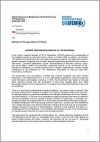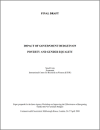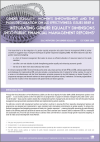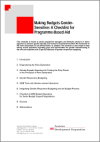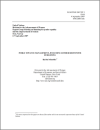FOUND 9 RESULTS
Paper discussing the definition and measurement of Sustainable Development Goal (SDG) Indicator 5.c.1 (reclassified to Tier II) and discussing the relationship of SDG Indicator 5.c.1 with other Indicators.
The following report, published by The Nordic Council of Ministers, is part of a Nordic cooperation project that strives to contribute to the...
This fact sheet was produced by UNIFEM in 2007 under the UNIFEM sub -regional programme "Gender-Responsive Budgeting in South East Europe: Advancing...
In this paper, Simel Esim (2000) focuses on expenditure and revenue instruments of fiscal policy as strategic entry points for engendering macroeconomics. The paper also includes a discussion of the potential implications of monetary policy and overall fiscal stance on poverty and gender equality.
This paper by Simel Esim (2000) explores the revenue side of gender budgeting. Esim also discusses policies and suggests strategies for gender-sensitive budgeting.
This Issues Brief published by the DAC NETWORK on Gender Equality in October 2010 is on the integration of a gender equality perspective into public financial management (PFM) in partner countries. It suggests ways of using the techniques of gender-responsive budgeting (GRB). The Brief makes the case that gender responsive budgeting: is a form of financial management that seeks to ensure an efficient allocation of resources based on the needs identified can offer a win-win situation by both...
This checklist is meant to assist programme managers and thematic advisors in donor agencies to advance gender equality and women's empowerment within the framework of the Paris Declaration on aid effectiveness. It is also meant to help in asking crucial questions regarding gaps and opportunities for gender mainstreaming in the new aid modalities with a special emphasis on gender responsive budgeting. The document was published by the Austrian Development Cooperation in 2009.
This paper explains what GRB is, what GRB work has help achieved and how it can further contribute to achieving gender equity and equality. The paper also presents some of the challenges of doing GRB work and concludes with a set of recommendations to institutionalize a gender equality perspective in public finance.
This book aims to contribute to the evolving understanding of public expenditure management as a political, rather than a purely technical, process. In particular, it explores the ways in which a rights approach can contribute to strengthening pro-poor voice and outcomes in budget processes. It identifies issues, partners, tools and methods that may help development actors to support citizen accountability and a pro-poor, gender-equitable, focus in public expenditure management.

